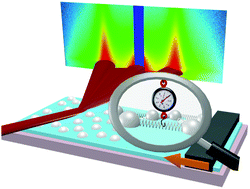In situ structure and force characterization of 2D nano-colloids at the air/water interface†
Abstract
The control of self-assembly and the related interactions among nanoparticles (NPs) at liquid surfaces and interfaces represents a stimulating experimental challenge to fully understand the behaviour of nano-colloids confined in a 2D asymmetric environment, in turn prompting the building of novel NP-based functional monolayers. Here, we first investigate the structural evolution of a model mixed surfactant/NP monolayer as a function of the surfactant/NP bulk ratio finding that, at ratios lower than 20, the adsorption at the air/water interface of surfactant-decorated NPs is dominant. We then employed these 2D nano-colloidal monolayers as model systems for grazing incidence small angle X-ray scattering measurements, performed using synchrotron radiation, while compressing the monolayers in a Langmuir trough. The simultaneous determination of the compression work and the related reduction of the inter-particle distance at the interface enabled, for the first time, the quantitative characterization of the forces acting between adsorbed NPs, as well as their dispersion law with the inter-particle distance. Distinct surfactant reorganization processes are proposed to interpret the measured forces and the characteristic inter-particle distances.



 Please wait while we load your content...
Please wait while we load your content...